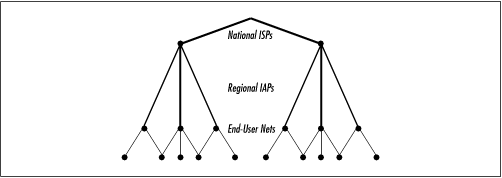The Internet Today
Over time, the ARPAnet evolved into an open “network-of-networks” using TCP/IP, with educational, commercial, and other organizations connected to each other through an interwoven mesh of networks. Today this type of mesh architecture is far less common, replaced by a much more structured hierarchy.
Rather than organizations connecting to each other directly, most organizations now connect to a local network access provider who routes network traffic upwards and outwards to other end-point networks.
Generally speaking, there are only a handful of top-level Internet Service Providers (ISPs), each of which provide major interconnection services around the country or globe. Most of these firms are telecommunications companies that specialize in large-scale networking (such as long-distance providers like MCI WorldCom and Sprint).
Below these top-level carriers are local or regional access providers who offer regional access and lower-speed connection services to end users directly (these mid-level carriers are sometimes referred to as Internet Access Providers, or “IAPs”). This design is represented in Figure 1.3.

Visually, the Internet can be thought of as a few major networking companies who provide large-scale “backbone” services around the world, followed by a large number of secondary providers that resell ...
Get Internet Core Protocols: The Definitive Guide now with the O’Reilly learning platform.
O’Reilly members experience books, live events, courses curated by job role, and more from O’Reilly and nearly 200 top publishers.

